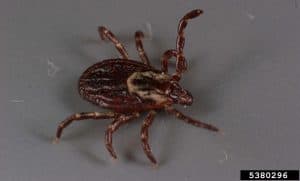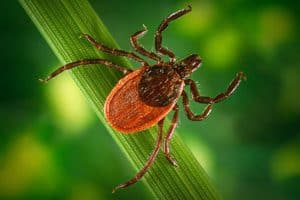MAY 2020

Figure 1. Female American dog tick. Courtesy: Gary Alpert, Harvard University, Bugwood.org
The Upper Midwest states share a number of similarities – largely agricultural, lakes and rivers throughout, bitterly cold winters, and 6 legged arachnids, commonly known as ticks.
Ticks arrive just as the warm spring weather tempts us to head outdoors, and they can be problematic as they can carry bacterial disease for both people and pets.
Patrick Wagner is an Entomologist with South Dakota State University Extension. He recently featured an article on how to avoid ticks in our area and the best methods for prevention. Read his article and check out the many resources available on tick prevention, removal, and implications ticks carry with possible disease.
The article is reprinted below with permission.
Ticks Becoming Active in South Dakota
Patrick Wagner
SDSU Extension Entomology Field Specialist
The arrival of spring in South Dakota means warmer weather and more outdoor activities. However, it also brings an increase in tick activity (Figure 1). Spring weather can be conducive to ticks, because wet weather is favorable for their development and survival. They require blood to fulfill their nutritional needs and will use humans as a food source. Some species can also carry bacterial diseases that are a threat to human health. The best way to avoid ticks is to be watchful when spending time outdoors and to check yourself for ticks after returning indoors. Furthermore, you can help ward off ticks by wearing protective clothing and applying insect repellent before you go outdoors.
Preventing Tick Bites
Ticks are most abundant in tall grass, forested areas, and near water sources (i.e., lakes, streams, etc.). To help protect yourself, it’s a good idea to wear a long-sleeved shirt, long pants, and shoes with long socks. Also, properly apply a repellent containing an active ingredient labeled to work against ticks. Insect repellants containing permethrin may be sprayed onto clothes and shoes as well to repel ticks through multiple outings.
After being outdoors, you should check yourself for ticks that may have gotten onto your body. Common places to check include the scalp, ears, underarms, back, waist, belly button, pelvic area, and legs. If a crawling tick is observed, immediately remove and dispose of it. When disposing of a tick, make sure to thoroughly crush it before flushing or discarding in the trash. Ticks have very sturdy exoskeletons, and you may need to use a tool such as pliers to effectively kill them. It is also important to note that, as juveniles, ticks can be very small and aren’t as easy to spot.
Removing an Embedded Tick
If a tick is left on the body for an extended period of time, it will eventually embed itself into the skin and begin feeding. Embedded ticks should be removed promptly but carefully to avoid squeezing them. Squeezing can expel the contents of the tick into the wound, which greatly increases the chances of contracting a tick-borne disease.
To safely remove an embedded tick, first grasp the tick with pointy tweezers as close to the skin as possible. Next, pull the tick straight out with slow, steady force. Once the tick is removed, disinfect the bite area with rubbing alcohol or soap and water. If you would like to have the tick identified, bring it to your healthcare provider in rubbing alcohol or in a sealed container. If you are concerned about a tick bite or develop other symptoms after the bite, contact your healthcare provider immediately.
See original story: https://extension.sdstate.edu/ticks-becoming-active-south-dakota

